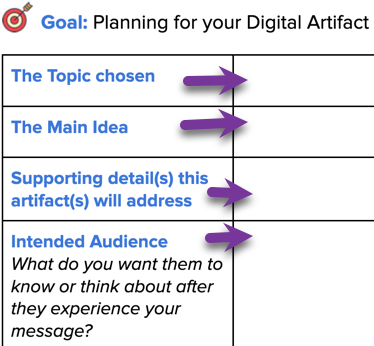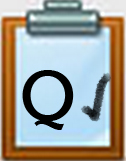Q3 Creating Your Digital Artifact: Plan
TO Create your plan:
Step 1. Make a copy or download and save this 17.Q3 Plan & Create Your Digital Artifact document.
- If you are working with a group, each member should download their copy of the Plan and Create document and add their initials to the file name.
Refer back to your 17.Q2 Worklog. In the Assign Parts section of the Work log, copy the supporting detail assigned to you (Topic, Main Idea, Supporting Detail(s), and your Intended Audience).
Paste or type it at the top of your own 17.Q3 Plan & Create Digital Artifact document as shown below.

Step 2. Reviewing Digital Media Tools: Review the Advantages and Disadvantages that you and your teammates come up with for each tool in number 6 from your 17.Q1 Analysis of Digital Artifact Chart in Quest 1 (refer back to the copy that one of your teammates has shared with you and your teacher).
Step 3. Selecting Digital Media Tools: Consider the message you want to convey and the supporting detail(s) you identified (or were assigned to as a group member). Now, select a software application to communicate your message.
Competencies & Standards
MITECS Michigan Integrated Technology Competencies for Students, and
1. Empowered Learner
d. Understand the fundamental concepts of technology operations, demonstrate the ability to choose, use and troubleshoot current technologies, are able to transfer their knowledge to explore emerging technologies
5. Computational Thinker
c. Break problems into component parts, extract key information, and develop descriptive models to understand complex systems or facilitate problem-solving
6. Creative Communicator
a. Choose the appropriate platforms and tools for meeting the desired objectives of their creation or communication
b. Create original works or responsibly repurpose or remix digital resources into new creations
c. Communicate complex ideas clearly and effectively by creating or using a variety of digital objects such as visualizations, models or simulations
d. Publish or present content that customizes the message and medium for their intended audiences
Websites and Documents
21T4S Documents & Quizzes




